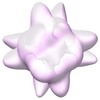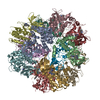[English] 日本語
 Yorodumi
Yorodumi- EMDB-5047: Inosine-5-monophosphate dehydrogenase structure : Structural surv... -
+ Open data
Open data
- Basic information
Basic information
| Entry | Database: EMDB / ID: EMD-5047 | |||||||||
|---|---|---|---|---|---|---|---|---|---|---|
| Title | Inosine-5-monophosphate dehydrogenase structure : Structural survey of large protein complexes in Desulfovibrio vulgaris Hildenborough (DvH) | |||||||||
 Map data Map data | Inosine-5-monophosphate dehydrogenase from Desulfovibrio vulgaris Hildenborough (DvH) | |||||||||
 Sample Sample |
| |||||||||
 Keywords Keywords | Inosine-5-monophosphate dehydrogenase /  Desulfovibrio vulgaris / DvH / IMP dehyrogenase Desulfovibrio vulgaris / DvH / IMP dehyrogenase | |||||||||
| Method |  single particle reconstruction / single particle reconstruction /  negative staining / Resolution: 19.0 Å negative staining / Resolution: 19.0 Å | |||||||||
 Authors Authors | Han B-G / Dong M / Liu H / Camp L / Geller J / Singer M / Hazen TC / Choi M / Witkowska HE / Ball DA ...Han B-G / Dong M / Liu H / Camp L / Geller J / Singer M / Hazen TC / Choi M / Witkowska HE / Ball DA / Typke D / Downing KH / Shatsky M / Brenner SE / Chandonia J-M / Biggin MD / Glaeser RM | |||||||||
 Citation Citation |  Journal: Proc Natl Acad Sci U S A / Year: 2009 Journal: Proc Natl Acad Sci U S A / Year: 2009Title: Survey of large protein complexes in D. vulgaris reveals great structural diversity. Authors: Bong-Gyoon Han / Ming Dong / Haichuan Liu / Lauren Camp / Jil Geller / Mary Singer / Terry C Hazen / Megan Choi / H Ewa Witkowska / David A Ball / Dieter Typke / Kenneth H Downing / Maxim ...Authors: Bong-Gyoon Han / Ming Dong / Haichuan Liu / Lauren Camp / Jil Geller / Mary Singer / Terry C Hazen / Megan Choi / H Ewa Witkowska / David A Ball / Dieter Typke / Kenneth H Downing / Maxim Shatsky / Steven E Brenner / John-Marc Chandonia / Mark D Biggin / Robert M Glaeser /  Abstract: An unbiased survey has been made of the stable, most abundant multi-protein complexes in Desulfovibrio vulgaris Hildenborough (DvH) that are larger than Mr approximately 400 k. The quaternary ...An unbiased survey has been made of the stable, most abundant multi-protein complexes in Desulfovibrio vulgaris Hildenborough (DvH) that are larger than Mr approximately 400 k. The quaternary structures for 8 of the 16 complexes purified during this work were determined by single-particle reconstruction of negatively stained specimens, a success rate approximately 10 times greater than that of previous "proteomic" screens. In addition, the subunit compositions and stoichiometries of the remaining complexes were determined by biochemical methods. Our data show that the structures of only two of these large complexes, out of the 13 in this set that have recognizable functions, can be modeled with confidence based on the structures of known homologs. These results indicate that there is significantly greater variability in the way that homologous prokaryotic macromolecular complexes are assembled than has generally been appreciated. As a consequence, we suggest that relying solely on previously determined quaternary structures for homologous proteins may not be sufficient to properly understand their role in another cell of interest. | |||||||||
| History |
|
- Structure visualization
Structure visualization
| Movie |
 Movie viewer Movie viewer |
|---|---|
| Structure viewer | EM map:  SurfView SurfView Molmil Molmil Jmol/JSmol Jmol/JSmol |
| Supplemental images |
- Downloads & links
Downloads & links
-EMDB archive
| Map data |  emd_5047.map.gz emd_5047.map.gz | 1.1 MB |  EMDB map data format EMDB map data format | |
|---|---|---|---|---|
| Header (meta data) |  emd-5047-v30.xml emd-5047-v30.xml emd-5047.xml emd-5047.xml | 11.2 KB 11.2 KB | Display Display |  EMDB header EMDB header |
| Images |  emd_5047_1.jpg emd_5047_1.jpg | 35.8 KB | ||
| Archive directory |  http://ftp.pdbj.org/pub/emdb/structures/EMD-5047 http://ftp.pdbj.org/pub/emdb/structures/EMD-5047 ftp://ftp.pdbj.org/pub/emdb/structures/EMD-5047 ftp://ftp.pdbj.org/pub/emdb/structures/EMD-5047 | HTTPS FTP |
-Related structure data
| Related structure data |  5041C  5042C  5043C  5044C  5045C  5046C C: citing same article ( |
|---|---|
| Similar structure data |
- Links
Links
| EMDB pages |  EMDB (EBI/PDBe) / EMDB (EBI/PDBe) /  EMDataResource EMDataResource |
|---|
- Map
Map
| File |  Download / File: emd_5047.map.gz / Format: CCP4 / Size: 1.3 MB / Type: IMAGE STORED AS FLOATING POINT NUMBER (4 BYTES) Download / File: emd_5047.map.gz / Format: CCP4 / Size: 1.3 MB / Type: IMAGE STORED AS FLOATING POINT NUMBER (4 BYTES) | ||||||||||||||||||||||||||||||||||||||||||||||||||||||||||||||||||||
|---|---|---|---|---|---|---|---|---|---|---|---|---|---|---|---|---|---|---|---|---|---|---|---|---|---|---|---|---|---|---|---|---|---|---|---|---|---|---|---|---|---|---|---|---|---|---|---|---|---|---|---|---|---|---|---|---|---|---|---|---|---|---|---|---|---|---|---|---|---|
| Annotation | Inosine-5-monophosphate dehydrogenase from Desulfovibrio vulgaris Hildenborough (DvH) | ||||||||||||||||||||||||||||||||||||||||||||||||||||||||||||||||||||
| Voxel size | X=Y=Z: 3.5 Å | ||||||||||||||||||||||||||||||||||||||||||||||||||||||||||||||||||||
| Density |
| ||||||||||||||||||||||||||||||||||||||||||||||||||||||||||||||||||||
| Symmetry | Space group: 1 | ||||||||||||||||||||||||||||||||||||||||||||||||||||||||||||||||||||
| Details | EMDB XML:
CCP4 map header:
| ||||||||||||||||||||||||||||||||||||||||||||||||||||||||||||||||||||
-Supplemental data
- Sample components
Sample components
-Entire : Inosine-5-monophosphate dehydrogenase from Desulfovibrio vulgaris...
| Entire | Name: Inosine-5-monophosphate dehydrogenase from Desulfovibrio vulgaris Hildenborough (DvH) |
|---|---|
| Components |
|
-Supramolecule #1000: Inosine-5-monophosphate dehydrogenase from Desulfovibrio vulgaris...
| Supramolecule | Name: Inosine-5-monophosphate dehydrogenase from Desulfovibrio vulgaris Hildenborough (DvH) type: sample / ID: 1000 / Oligomeric state: Octamer / Number unique components: 1 |
|---|---|
| Molecular weight | Experimental: 418 KDa / Theoretical: 418 KDa |
-Macromolecule #1: Inosine-5-monophosphate dehydrogenase
| Macromolecule | Name: Inosine-5-monophosphate dehydrogenase / type: protein_or_peptide / ID: 1 / Name.synonym: Inosine-5-monophosphate dehydrogenase / Oligomeric state: Octamer / Recombinant expression: No / Database: NCBI |
|---|---|
| Source (natural) | Cell: Desulfovibrio vulgaris Hildenborough / Location in cell: cytoplasmic |
| Molecular weight | Experimental: 418 KDa / Theoretical: 418 KDa |
-Experimental details
-Structure determination
| Method |  negative staining negative staining |
|---|---|
 Processing Processing |  single particle reconstruction single particle reconstruction |
| Aggregation state | particle |
- Sample preparation
Sample preparation
| Concentration | 0.03 mg/mL |
|---|---|
| Buffer | pH: 7 / Details: 10 mM HEPES buffer |
| Staining | Type: NEGATIVE Details: Three microliter of 2% w/v uranyl acetate stain was applied to the EM grid for 1 min. |
| Grid | Details: carbon-coated and glow-discharged 300 mesh copper grid |
| Vitrification | Cryogen name: NONE / Instrument: OTHER |
- Electron microscopy
Electron microscopy
| Microscope | JEOL 4000EX |
|---|---|
| Electron beam | Acceleration voltage: 400 kV / Electron source:  FIELD EMISSION GUN FIELD EMISSION GUN |
| Electron optics | Calibrated magnification: 40000 / Illumination mode: FLOOD BEAM / Imaging mode: BRIGHT FIELD Bright-field microscopy / Cs: 4.1 mm / Nominal defocus max: 2.0 µm / Nominal defocus min: 0.6 µm / Nominal magnification: 40000 Bright-field microscopy / Cs: 4.1 mm / Nominal defocus max: 2.0 µm / Nominal defocus min: 0.6 µm / Nominal magnification: 40000 |
| Sample stage | Specimen holder: Side entry room T / Specimen holder model: OTHER |
| Temperature | Average: 293 K |
| Alignment procedure | Legacy - Astigmatism: objective lens astigmatism was corrected at 60,000 times magnification |
| Date | Mar 3, 2008 |
| Image recording | Category: FILM / Film or detector model: KODAK SO-163 FILM / Digitization - Scanner: NIKON SUPER COOLSCAN 9000 / Digitization - Sampling interval: 6.35 µm / Number real images: 14 / Average electron dose: 17 e/Å2 Details: The images were scanned with a resolution of 6.35 micro m per pixel and later averaged 2 fold in each direction. Bits/pixel: 8 |
| Tilt angle min | 0 |
| Tilt angle max | 0 |
- Image processing
Image processing
| CTF correction | Details: Each particle |
|---|---|
| Final reconstruction | Algorithm: OTHER / Resolution.type: BY AUTHOR / Resolution: 19.0 Å / Resolution method: FSC 0.5 CUT-OFF / Software - Name: SPIDER / Number images used: 5814 |
 Movie
Movie Controller
Controller









